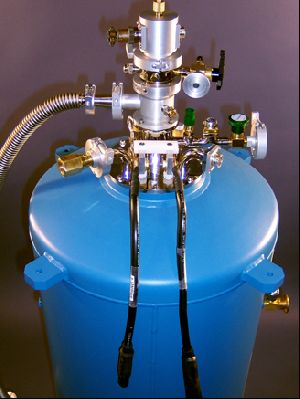
Vertical Field Solenoid System
This is the most widely used configuration, and typically these systems have solenoids with bore diameters between 1 inch and 5 inches and homogeneities in the range of 1.0% to 0.01% over a 1 cm diameter spherical volume (DSV). Fields up to 9 Tesla are generated with NbTi solenoids and higher field solenoids > 9 Tesla generally require Nb3Sn conductor when operated at the normal boiling temperature of liquid helium (4.2K). Our standard magnet systems are offered with a VTI that could be operated over 1.5K to 325K. These could also be used with 3rd party He3 or dilution fridges. Custom systems include use of magnets that are designed for minimizing stray fields (i.e., active- shielding) or have reduced field compensation stages for use with dilution fridges. Cryogen free versions for most of the systems are also available.
...more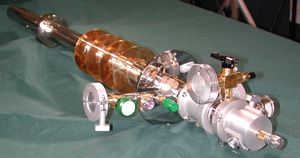
Variable Temperature Insert
The Variable Temperature Insert (or VTI) is a useful tool for studying material samples in a magnetic field at varying temperatures. The basic VTI consists of a cylindrical tubular structure that is inserted into the bore of a superconducting magnet. A sample is mounted onto a removable rod placed inside the VTI. The cylindrical structure separates the sample from the surrounding liquid helium environment. The temperature of the sample can be varied by flowing cold helium liquid or vapor through a throttle valve or by direct heating from an integrated heater. A cryogenic temperature controller can be supplied with the VTI. The VTI can be separate from the magnet for installation in a bottom-loading dewar or the magnet can be mounted onto the VTI. In this configuration, the VTI structure acts as an integrated support stand incorporating the magnet mount, current leads, liquid level instrumentation, fill and vent ports, and pressure relief valves. The Exchange-Gas VTI represents the simplest design and uses a single-walled tube in direct contact with the liquid helium. This tube can be evacuated or backfilled with helium gas. The sample is mounted on a removable rod within this tube and is cooled by thermal conduction between the backfilled gas and the cold tube wall. The sample can be heated by evacuating the sample tube and operating the sample mount integral heater. The exchange-gas style VTI provides responsive thermal control with reasonable temperature stability at a low cost. The Dynamic VTI provides improved thermal control by separating the sample from the liquid bath through a double-walled, vacuum insulated sample tube. The sample temperature is cooled by a flow of helium liquid or gas controlled via a throttle valve and is heated by integral heaters. The dynamic VTI provides excellent thermal response with greater sample thermal stability. The Integrated Dynamic and Exchange-Gas VTI combines the dynamic and exchange-gas VTI designs into a single unit. The cold flow from the dynamic portion cools the exchange-gas tube which, in turn, cools the sample through gas conduction. Integral heaters in both portions provide excellent heating control. The integrated dynamic and exchange-gas VTI design allows for the best sample thermal stability.
...more
Storage Dewar Magnet
The simplest magnet system is one where a sample insert has a small 6T magnet bolted at the bottom. Such an insert would have an integral variable temperature insert with sample space of 25 mm. These inserts are very effective in performing transport studies on nano size specimens and can be a useful tool to demonstrate the Quantum Hall Effect for educational purposes or for prescreening samples before they are tested at facilities that are not easily accessible.
...more
Multi Axis Vector Magnet
MAxes TM systems provide variable magnetic field on the three principal axes and are particularly useful for orientation studies on a variety of samples. The system is comprised of a 2 or 3-axis superconducting magnet, low helium consumption current leads, magnet dewar and other associated electronics. Typical specifications include magnetic fields up to 9T for the principal vertical axis, 2.0/3.0 inch vertical clear bore and up to 3T rotating vector using any combination of x, y and z-axis magnets. It is possible to use the magnet system with existing sample inserts or AMI can provide a variable temperature insert which operates from 1.5K to 300K. Our users have also used such systems with 3rd party He3 systems and dilution refrigerators. The MAxes TM system provides a unique way to rotate the magnetic field vector on the three principal axes and this has proved useful in performing anisotropic studies on a variety of materials. MAxes TM systems have also been very useful in advancing research in the areas of spin based physics. The magnet system software provides automatic sequencing of power supply currents and thus magnetic fields that allow the user to specify and control the magnetic field vector from a single computer screen (below). The interface allows the user to enter the desired field vector of a 3-axis magnet in Cartesian, cylindrical, or spherical coordinates. Cryogen Free (CF- MAxes TM ) and Optical Access (Opti-MAxes TM ) systems are also available. Customers are finding the combination of a Dilution Refrigerator with a MAxes TM system useful in the study of Quantum Mechanics and other nanoscale studies.
...more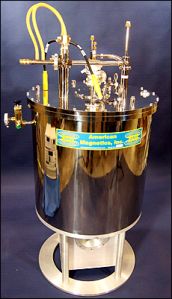
Magneto Optical Split Coil
A typical magneto-optical system offers optical access in two planes with magnetic field in either horizontal or vertical field configuration. A standard system is available with a low temperature insert operable over 1.5K to 325K and magnetic fields up to 10T. These systems are available with a wide range of window materials. Actively shielded and cryogen free versions are being routinely offered for all applications.
...more
Liquid Level Sensor
Capacitance-based liquid level sensors, used in conjunction with Models 175, 185, 186, and 286 cryogen monitors and controllers, are typically manufactured of 38 inch OD stainless steel tubing and will operate with virtually all common laboratory cryogenic liquids including nitrogen, liquid neon, and liquid xenon. Sensors for common Industrial Use Cryogenics are also available for materials such as liquid oxygen (LOx), liquid hydrogen LH2), liquid carbon dioxide (liquid CO2), liquified or liquefied natural gas (LNG), liquid argon, liquid propane, and liquid butane. Upon request, special assembly techniques can be applied for sensors required for liquid oxygen or hydrogen measurement. Sensors can be supplied in single-section overall lengths of up to 50 feet. Alternatively segmented sensors are available that can be bolted together during installation.
...more
Magnet Support Stands
AMI offers support stands for magnet systems associated with bucket-style or similar dewars where the magnet assembly is installed vertically and mounted to the dewar top flange. These support stands hold the magnet in position and provide attachment points for current leads, liquid level measurement instruments, electrical connections, fill and vent ports, and other associated equipment such as blow-out tubes quench relief ports. AMI support stands are designed and constructed of low-thermal conductivity materials for minimum cryogen losses. AMI support stands can be designed to allow vertical access to the magnet bore for custom instrumentation or cryogenic inserts.
...more
Liquid Helium Level Sensors
The Model 150A is a lightweight, hand-held meter for use with helium storage dewars on loading docks or in storage rooms, or in remote helium level operations where line power is unavailable. The Model 150A includes a 3.5 digit LCD display with readout accuracy of 0.5%, and a push-to-read switch that allows level measurements to made within seconds. The Model 150A is designed for use with AMI liquid helium level sensors up to 60" in active length. Battery powered convenience The unit is powered by a rechargeable, sealed lead-acid battery pack. The battery pack provides capacity for hundreds of readings between recharges. Also, a Model 150A with fully-charged batteries can be stored for up to a year at room temperature before battery recharging is required. The Model 150A is shipped with a battery charger.
...more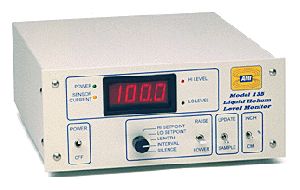
Liquid Helium Level Monitor
The Model 135 is an advanced liquid helium level monitor which incorporates AMI's patented sample-and-hold design with automatic helium level sensor vacuum burnout protection. The Model 135 is ideal for operation in systems where it is important to monitor the liquid helium level while also minimizing the helium losses. Microprocessor-based electronics provide 0.1% readout accuracy. Nonvolatile, read only memory maintains instrument calibration without battery backup. Watchdog timer circuitry and low line voltage (brownout) detector prevent microprocessor lock-up and provide fail-safe operation. High and low alarm functions The Model 135 adds "High" and "Low" alarm setpoints which activate front panel LED warning indicators and rear panel relay outputs in the event of an overfill or liquid loss condition. The alarms also energize an audible warning which can be silenced from the front panel. "High" and "Low" setpoints are programmable from 0 to 100 percent of sensor active length. Minimal liquid helium losses In order to minimize liquid helium loss, the Model 135 automatically energizes the liquid helium level sensor at user programmable time intervals and monitors the normal (resistive) zone as it progresses from the top of the sensor toward the liquid surface. As soon as the normal zone reaches the liquid surface, the level reading is saved and the current in the sensor is turned off until the next sample interval occurs. An LED sensor current indicator is illuminated during each sample. Sample intervals are user programmable from the front panel and can be set between "0.0" (continuous reading) to "600.0" minutes or hours. A manual update switch provided on the front panel can also be set to obtain continuous readings during a helium transfer period or to manually force an immediate measurement. Sensor burnout protection The Model 135 provides automatic helium level sensor vacuum burnout protection. A liquid helium level sensor energized in a vacuum environment will self-heat to the point of burnout within seconds. AMI’s innovative microprocessor-based circuitry detects incipient sensor burnout and de-energizes the sensor before damage can occur. A 5% increase in sensor resistance will trigger this protection, causing the current to be switched off for 6 seconds before attempting to resume normal operation. Convenient display The Model 135 is equipped with a 4 digit LED digital display which provides liquid helium level indication in inches, centimeters, or percent as selected by a front panel switch. Front panel sensor calibration allows the user to calibrate the instrument quickly and easily for any length sensor. Calibration can be performed in either inches or centimeters of sensor active length with automatic reading crossover between inches, centimeters, and percent.
...more
Liquid Helium Level Meter
The low-cost Model 110A liquid helium level meter reliably measures the helium level in a dewar. A 3.5 inch analog display provides 0-100% liquid helium level indication. A 0-10 V recorder output is provided on the rear panel of the instrument. The Model 110A can be used with any AMI liquid helium level sensor up to 60 inches in active length. The Model 110A is commonly used for quick and accurate level indication in portable helium storage containers such as those pictured here. Simply plug the unit into the nearest outlet, read the level in percent and then covert to volume using the transport dewar strapping sheet. Level sensors can be built-in by the dewar manufacturer or provided direct from AMI with a metal top sleeve for sealing through the withdrawal port using the standard compression fitting. Simple sheet metal brackets are used to create a platform for the level instrument.
...more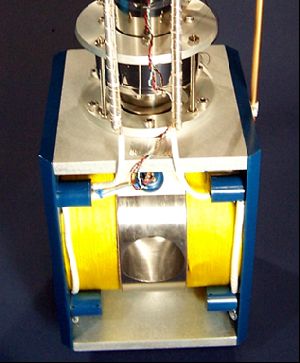
Horizontal Field Split Coil System
Magnets with radial access ports are manufactured for a cold bore or for warm bore applications. The radial ports allow access perpendicular to the magnetic field. The cold bore magnet systems are ideally suited for use in horizontal field configuration, and are extremely useful for performing angular dependent studies on samples in presence of magnetic field. Our standard magnet systems are offered with a VTI that could be operated over 1.5K to 325K. Custom systems include use of magnets that are designed for minimizing stray fields (i.e., active- shielding)
...more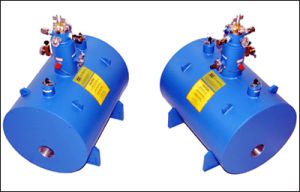
Horizontal Bore Axial Feild System
Room temperature bore systems give the user access to the magnetic field in an ambient condition environment. Such systems are useful when beams, temperature sensitive samples, vacuum chambers or furnaces must be placed in the bore. Systems containing smaller sized solenoids (to left) may have a rectangular tail section, horizontally mounted magnet bore and a larger liquid helium reservoir above the magnet. Systems with larger magnets and horizontal fields will often be provided like the units shown (below). Custom systems include use of magnets that are designed for minimizing stray fields (i.e., active- shielding).
...more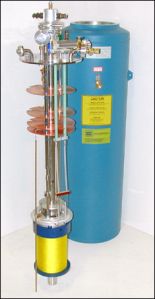
High Field Magnet System
Many solid state physics experiments require the highest possible magnetic fields for high H/T or materials characterization measurements, particularly of superconductors. Using a combination of Nb3Sn and NbTi, fields up to 16 Tesla are now possible. A lambda point refrigerator can reduce the temperature to 2.2 K, while allowing refilling at atmospheric pressure. AMI manufactures both high field solenoid and split coil systems. The system shown here is integrated with a VTI and lambda plate refrigerator unit.
...more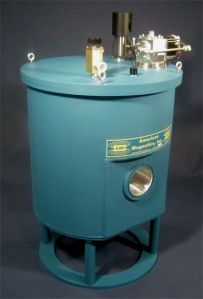
Cryogen Free
Magnets wound from NbTi or Nb3Sn may be conduction-cooled and operate in vacuum without the need of liquid helium(e.g., “cryogen-free”). Cryogen free systems can replace most conventional liquid helium cooled magnet systems if a compact system is required, or if liquid helium is undesirable or unavailable.Current leads constructed with HTS material allow the system to be cooled using either a G-M or Pulse Tube type cryocooler.
...more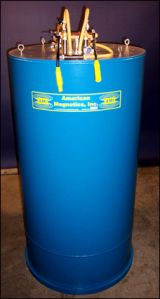
Bottom Loading Magnet System
Bottom loading magnet systems are typically used when a small diameter (e.g., 8 inches or less), top-loading sample insert is to be used and the magnet is relatively large. The magnet is installed from the bottom of the dewar through a series of bolted flanges and installed on the bottom of liquid helium reservoir. This allows the dewar neck diameter to be small, thus minimizing the liquid helium consumption. Bottom loading systems can be used with solenoids, split coils, gradient coils, etc.
...more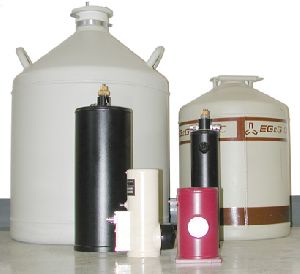
Auto Fill System
These are just a few of the many unattended auto-fill applications for systems that need uninterrupted LN2 temperature environments: Crystallography CCD and HgCdTe Detectors X-ray and Gamma-ray spectro-scopy systems Biological sample or single-crystal storage Astronomy Florescence and Chemilumine-scence spectroscopy Gravity-Feed Gravity-feed systems are an AMI innovation applied in situations where the target dewar must be kept contuously full. In these applications, the source dewar is mounted above the target dewar and is the object of the autofill function. For more details, refer to the Autofill Systems Brochure in PDF format and the Cryogenic Liquid Level Application Notes
...moreBe first to Rate
Rate ThisOpening Hours